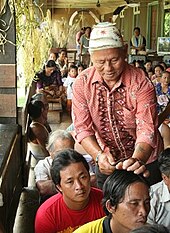|
Punan Bah
Punan Bah or Punan[1] is an ethnic group found in Sarawak, Malaysia and Kalimantan, Indonesia.[2] The Punan Bah people are distinct and unrelated to the semi-nomadic Penan people.[3][4] Their name stems from two rivers along the banks of which they have been living since time immemorial. They have other names including Mikuang Bungulan or Mikuang and Aveang Buan but those are used only ritually nowadays. The Punan (or Punan Ba) have never been nomadic. In the old days,[when?] they based their living on a mixed economy – Swidden agriculture[5] with hill paddy as the main crop, supplemented by a range of tropical plants which include maniok, taro, sugar cane, tobacco, etc. Hunting, especially wild boar, fishing, and gathering of forest resources,[5] are the other important factors in their economy. However, in the late 1980s, many Punan, notably the younger, more educated, gradually migrated to urban areas such as Bintulu, Sibu, Kuching and Kuala Lumpur in search of better living. However, they didn't abandon their longhouses altogether. Many would still return home, especially during major festivities such as Harvest Festival or Bungan festival as it is known among Punan. Punan is a stratified society of 'laja' (aristocrats), 'panyen' (commoners), and 'lipen' (slaves). This determines their historical traditions that have been preserved. Just like most of the history of European Middle Ages is linked to and mainly concerned the various ruling monarchs, so are the historical and mythical traditions of Punan closely connected to their rulings aristocrats. Relation to sub-ethnic Punans There is this common misunderstanding that all the so-called Punan on the island of Borneo are related and belong to the same tribe.[citation needed] In Sarawak, for example, there is the confusion between Punan and Penan.[4] On the other hand, throughout the island of Borneo, the term Punan was often indiscriminately used during colonial times to refer to the then (unknown or yet to be classified) tribes as such as Punan Busang, Penihing, Sajau Hovongan, Uheng Kareho, Merah, Aput, Tubu, Bukat, Ukit, Habongkot, Penyawung as Punan. This heritage from colonial times still remain until today. As a result, there are now more than 20 different tribes or ethnics with the name Punan that may be related or unrelated to one another in the island of Borneo. These tribes include:
Ethnic classificationOfficially, as under the Sarawak Interpretation Ordinance,[8] Punan is group under Kajang together with Sekapan, Kejaman, Lahanan and Sihan. Unofficially, they are also included in the politically coined term Orang Ulu – popularised by a political association known as Orang Ulu National Association or (OUNA). The association is a Kayan and Kenyah dominated association which they established in 1969. GeneticsResearch on Northeast Bornean Punan communities revealed them to display strong genetic ancestry connections to each other, and that they form an outgroup to other Austronesian-speaking groups. The results of a 2023 study "support long-term occupation of Borneo by Punan-related people" predating the arrival of other Austronesian-speakers from which they diverged earlier.[9] Punan longhousesPunan are mostly found around Bintulu, Sarawak. Punan peoples can only be found at Pandan, Jelalong and Kakus in Bintulu Division; along the Rajang River, their longhouses dotted areas spanning from Merit District to lower Belaga town. The Punan are believed[by whom?] to be one of the earliest peoples to have settled in the central part of Borneo, the Rajang River and Balui areas together with the Sekapan, Kejaman and Lahanan. However, the mass migrations of Kayans, subsequently followed by the warfaring Ibans into Rejang and Balui areas approximately some 200 years ago, forced the Punan communities living in these areas retreating to Kakus and subsequently to Kemena basin. As of 2006, there were more than 10 Punan settlements (longhouses) found along the Rejang, Kakus, Kemena and Jelalong river. These settlements (longhouses) are:
The total Punan population is estimated to be around 3000–5000 people. Language Punan speak the Bah-Biau Punan language, one of the Punan languages. Although often confused with Penan, Punan is closer to the language spoken by the Sekapans and Kejamans. Here are some words spoken in Punan:
Religion and beliefsPunan traditional religion was a form of animist known as "Besavik". The Brooke era saw the arrival of Christian missionaries, bringing education and modern medicine into Sarawak. But the Punan communities remain with their traditional religion of Besavik and subsequently adopting a cult religion - Bungan brought by Jok Apui, a Kenyah from Kalimantan.[11] However, the late 1990s showed an increase in the number of Punan converting to Christianity. This is partly due to more and more Punan becoming educated and modernised. As of 2006, almost half of Punan are now Christian, leaving only the elderly, less educated still remain observing "Bungan" religion. The Punan have a unique burial custom. In the early days they did not bury their aristocrats or lajar. Instead they built a pole known as kelirieng of 50-meter height to lay down their beloved leaders. In Sarawak it is estimated that there are fewer than 30 kelirieng left standing. The Punan still practise a secondary burial ceremony, whereby the dead body is kept at their longhouses for at least 3–7 days. This is partly to give more time for far-away relatives to pay their last respects to the deceased. Current associationsThere are two Punan associations in existence today:
References
External links
Wikimedia Commons has media related to Punan. |
||||||||||||||||||||||

